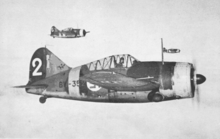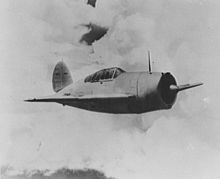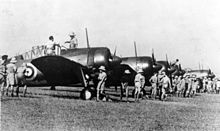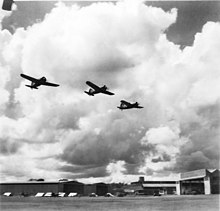Brewster F2A
| Brewster F2A Buffalo | |
|---|---|
 A US Navy F2A-3 in August 1942 |
|
| Type: | Fighter plane |
| Design country: | |
| Manufacturer: | |
| First flight: |
December 2, 1937 |
| Commissioning: |
April 1939 |
| Production time: |
1938 to 1941 |
| Number of pieces: |
509 |
The Brewster F2A Buffalo the Brewster Aeronautical Corporation was the first in combat units of the US Navy used fighter - monoplane . The machine was used by many air forces. She was relatively successful in aerial combat despite her weaknesses in design and performance. The machines were withdrawn from US air combat units as early as April and June 1942 because of their losses.
development
The aircraft emerged from a US Navy tender in 1936 for a new carrier-based fighter. The result was a monoplane with folding wings, retractable landing gear and a catch hook . The Brewster was in competition with machines such as the Grumman F4F Wildcat and Seversky P-35 . Since the Buffalo was Brewster's first fighter aircraft design, according to the guidelines of the US Navy at the time, the name should actually have been Brewster FA . The different designation is probably due to the fact that the designation FA was already assigned to the General Aviation XFA double-decker fighter aircraft .
The first prototype XF2A-1 flew for the first time in December 1937. After tests by the US Navy, 54 machines of the type F2A-1 were ordered in June 1938 . The first flight of the F2A-1 took place in January 1938.
variants
- F2A-1: 53 built
- F2A-2: 43 built
- F2A-3: 108 built
- B-239: 44 to Finland
- B-339B: 40 to Belgium
- B-339C / D: 72 built for the Netherlands
- B-339E: 170 to Great Britain
- B-339-23: 20 to the Netherlands
Mission history
The first ten machines reached the US Navy in June 1939 and went to the Fighter Squadron VF-3 on the USS Saratoga . The remaining 44 F2A-1 went to Finland, where they were used successfully until 1944. To the great surprise of the Finns, all parts of the US Navy such as cannons, sights, instruments and carrier equipment had been removed from the machines in the factory.
The 43 built F2A-2 had a more powerful engine (Wright R-1820-40 with 1200 hp), an electrically adjustable propeller and an improved carburetor. In the VF-3 Fighter Squadron, the F2A-2 replaced the F2A-1, and the VF-2 Fighter Squadron of the USS Lexington received this version. Eight F2A-1 were modified to F2A-2 and served in 1941 in the reconnaissance squadron VS-201 on the escort carrier USS Long Island .
It was followed by the F2A-3 version . The fuselage was lengthened by 25 centimeters and more fuel tanks were installed. The cockpit and fuel tanks were armored and the cockpit was modified to improve the pilot's view. Due to these changes, the weight of the machine increased and led to significantly impaired flight performance, only the range had been greatly improved. By April 1942, all F2A of the US Navy in the combat squadrons had been replaced by Grumman F4F and given to the US Marine Corps. Training squadrons in Miami flew the remaining F2A until 1944/45 before they were scrapped.
US Marine Corps
In the US Marine Corps , the VMF-211 and VMF-221 fighter squadrons flew the F2A. VMF-221 was able to shoot down a Kawanishi H8K 1 reconnaissance aircraft at Midway on March 10, 1942 . In the Battle of Midway , however, the squadron lost 13 of 20 machines on June 4, 1942. They were clearly inferior to the Japanese Mitsubishi A6M Zero and were then retired. Captain Philip R. White of VMF-221 said after the fight, “I believe that any commander who calls his pilots into combat in F2A-3 must consider his men lost before they do Have left the ground. ”In addition to the Buffalo's insufficient performance, there were other reasons for the high losses. The inexperienced American pilots used precisely the wrong aerial combat tactics when they involved the very experienced Japanese pilots in combat on bends .
Belgium
On December 11, 1939, Belgium ordered 40 F2A-2s as B-339B . However, only one machine could be delivered to Belgium before Belgium was occupied by German troops in 1940 . The German Air Force is said to have tested this aircraft. Six more B-339Bs were then shipped to France, but after the capitulation of France they were diverted to Martinique, where they were probably destroyed by American agents in 1940. The remaining aircraft were handed over to Great Britain. Here they were found to be unusable for air warfare in Europe and with the No. 805 used in the Middle East . A plane was captured by German troops in Crete.
Commonwealth
Although the British Aviation Ministry rejected the F2A in 1939 because the machines could not stand up to the German Messerschmitt Bf 109 , it ordered 170 F2A-2s as B-339E for use in the Far East in 1940 . Here the No. 67 and 243 of the RAF , No. 21 and 43 of the RAAF and No. 488 the RNZAF the Buffalo . Season No. 67 was stationed in Burma , the other squadrons in Singapore . In the first few months of the Pacific War , about 60-70 Buffalos were shot down, about 40 devastated and about 20 lost in accidents. Four were handed over to the Dutch Air Force and six were taken to India. For their part, the pilots of the Commonwealth Buffalos shot down about 80 Japanese planes.
Dutch East Indies
The Dutch Air Force ordered 144 Brewster B-339C and B-339D models, which were also essentially the same as the F2A-2. They had better engines (Wright R-1820-G105 or -G205). After the fall of the Netherlands, the order was reduced to 72 machines, which were delivered between April and September 1941. The Buffalo flew four squadrons (1-VLG V, 2-VLG, 3-VLV IV and 3-VLG V) . Staffel 2-VLG V helped the British defend Singapore , but returned to Java before its surrender . Missions were also flown in Borneo as bomber escorts and to secure space. They were seldom used as dive bombers against Japanese troop carriers. The Buffalos were too inefficient compared to the Japanese aircraft and flew their last mission from Java on March 7, 1942. 30 Buffalos were shot down and 15 devastated. The Dutch claimed 55 kills.
On Feb. 19, 1942 attacked eight Buffalos a 35 machines strong Japanese bomber formation to that of 20 Mitsubishi A6M - Zero was escorted -Jägern. Eleven Japanese planes were shot down with four losses of their own.
In 1941 the Netherlands ordered another 20 B-339-23 , the export version of the F2A-3. They were delivered in the spring of 1942 because of the fall of the Dutch East Indies, but diverted to Australia. There they received a coat of paint from the USAAF , which they passed on to Australia. The RAAF used six machines in the reconnaissance squadron No. 1 PRU one and nine in the Perth-based Season No. 25. In 1944 they were returned to the USAAF and scrapped.
Finland
The 44 Brewsters arrived too late for the winter war of 1939/40, but were very successful in the renewed war against the Soviet Union from 1941 onwards. The machine was not called “Buffalo” there, but “Taivaan helmi”, which means something like “heavenly pearl”. They were used by Jagdstaffel LeLv 24 from 1941 to 1944, then by HLeLv 26 until 1948. The machine was very easy to fly and pilots also called it “gentleman aircraft”, in contrast to the Messerschmitt Bf 109 , which they called “killer aircraft”. During their service, the F2A were awarded 496 kills out of 19 casualties, a rate of 26 to 1. The most successful Buffalo pilot was Hans Wind with 39 kills. The last aerial victory of a Brewster was on October 3, 1944 against a German Junkers Ju 87 after Finland had switched sides.

Finland received aircraft that were originally ordered by the US Naval Air Force (USNAF). Because of the urgency (Finland was already at war with the Soviet Union ) this delivery was brought forward. The aircraft specified by the USNAF for use on aircraft carriers were converted before delivery. Catapult harness and catch hooks were removed. The B-239 got Wright-R-1820-G5 radial engines with 950 bhp power and a simpler aiming device.
The planes were dismantled and shipped to Trollhättan in Sweden , where they were assembled by mechanics from the Norwegian Air Force . American and Finnish pilots were involved in the transfer to Finland. Only six aircraft reached Finland before the end of the war on March 3, 1940. They were given the numbers BW-351 to BW-394. Armored seat backs and reflex visors were added later . The Finns replaced the two 7.62mm machine guns with two 12.7mm machine guns in 1943.
During the war a successor to the Buffalo was worked on, but only a prototype called VL Humu was constructed. The last flight of a Brewster in Finnish service was on September 14, 1948. In 1948 the F2A / Humu prototype was restored and is now on display in the Central Finnish Aviation Museum in Tikkakoski. In 1998 the F2A "BW-372" was recovered in good condition from a lake in Karelia . After a few detours, the aircraft finally made it to the National Museum of Naval Aviation on Naval Air Station Pensacola (Florida) in August 2004 , which wants to restore it to the condition in which it was used by the Finnish Air Force.
Using the Brewster Buffalo

- VF-2, USS Lexington (CV-2)
- VF-3, USS Saratoga (CV-3)
- VS-201, USS Long Island (ACV-1)
United States Marine Corps
- VMF-211, Protection of the Palmyra Atoll
- VMF-221, in action in the Battle of Midway
Royal Air Force
- No. 60 Squadron
- No. 67 Squadron
- No. 71 Squadron
- No. 146 Squadron
- No. 243 Squadron (most of the pilots were from the RNZAF)
Fleet Air Arm
- No. 759 Squadron
- No. 760 Squadron
- No. 804 Squadron
- No. 805 Squadron
- No. 885 Squadron
Royal Australian Air Force
- No. 1 Photographic Reconnaissance Unit
- No. 21 Squadron
- No. 24 Squadron
- No. 453 Squadron
Royal New Zealand Air Force
- No. 14 Squadron
- No. 488 Squadron
Dutch Air Force
- 1-VLG-V
- 2-VLG-V
- 3-VLG-IV
- 3-VLG-V
Finnish Air Force
- LentoLaivue 24 / HävittäjäLentoLaivue 24 (1941–1944)
- HävittäjäLentoLaivue 26 (1944–1945)
Imperial Japanese Army Air Force
At least eight Buffalos were captured by the Japanese, some of these machines were repaired and flown with Japanese license plates for test purposes.
production
Acceptance of the Brewster F2A by the US Navy:
| version | 1938/1939 | 1940 | 1941 | 1942 | TOTAL |
|---|---|---|---|---|---|
| XF2A-1 | 1 | 1 | |||
| F2A-1 | 11 | 11 | |||
| F2A-2 | 43 | 43 | |||
| F2A-3 | 108 | 108 | |||
| B-239 Finland | 6th | 38 | 44 | ||
| B-339B Belgium | 40 | 40 | |||
| B-339C / D Netherlands East India | 39 | 33 | 72 | ||
| Buffalo Mk. I | 170 | 170 | |||
| B-339-23 Netherlands East India | 20th | 20th | |||
| TOTAL | 18th | 160 | 311 | 20th | 509 |
Technical specifications
| Parameter | Data F2A-1 |
|---|---|
| crew | 1 |
| length | 7.90 m |
| span | 10.7 m |
| height | 3.6 m |
| Wing area | 19.4 m² |
| Wing extension | 5.9 |
| Empty mass | 1717 kg |
| Takeoff mass | 2286 kg |
| Engine | a Wright R- 1820-34 radial engine with 708 kW (950 hp) |
| Top speed | 500 km / h at an altitude of 5500 m |
| Service ceiling | 10,100 m |
| Range | 1600 km |
| Armament | one 7.62-mm-MG and one 12.7-mm-MG (optionally two 12.7-mm-MGs in the wings) |
literature
- Peter M. Bowers : United States Navy Aircraft since 1911 . Naval Institute Press, Annapolis (Maryland) 1990. ISBN 0-87021-792-5
- Robert J. Cressmann (Ed.): A Glorious Page in Our History. The Battle of Midway, June 4-6, 1942 . Pictoral Histories Publishing, Missoula / Montana 1990. ISBN 0-929521-40-4
- Brian Cull: Buffaloes over Singapore. RAF, RAAF, RNZAF and Dutch Brewster Fighters in action over Malaya and the East Indies 1941–42 . London 2003. ISBN 1-904010-32-6
- Kalevi Keskinen, Kari Stenman, Klaus Niska: Brewster Model 239 . - Suomen Ilmavoimien Historia 1. Apali Oy.
- Lentäjän Näkökulma 2 = Pilot's viewpoint 2 by Jukka Raunio. 1993. - 255 p. ISBN 951-96866-0-6
- Jim Maas: F2A Buffalo in Action (Squadron / Signal publications, 1988). ISBN 0-89747-196-2
Web links
- US Naval Historical Center website for F2A
- "Annals of the Brewster Buffalo" by Daniel Ford (engl.)
- History of the Finnish F2A BW-372
- Brewster F2A Buffalo at daveswarbirds.com (Engl.)
- Variants of the Brewster F2A at joebaugher.com (engl.)
Individual evidence
- ↑ a b c joebaugher.com: Brewster 239
- ↑ Statistical Digest of the USAF 1946, p. 100 ff .; www.uswarplanes.net





